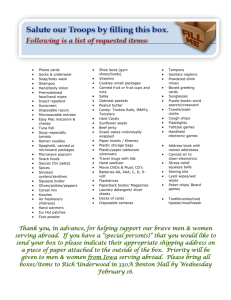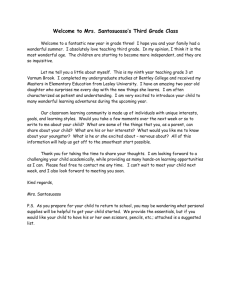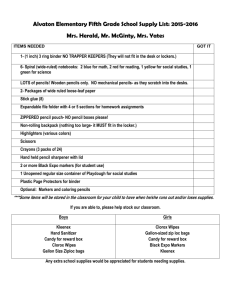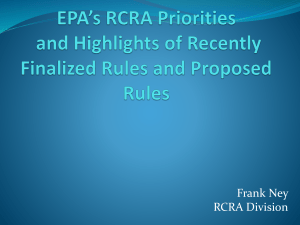states likely
advertisement
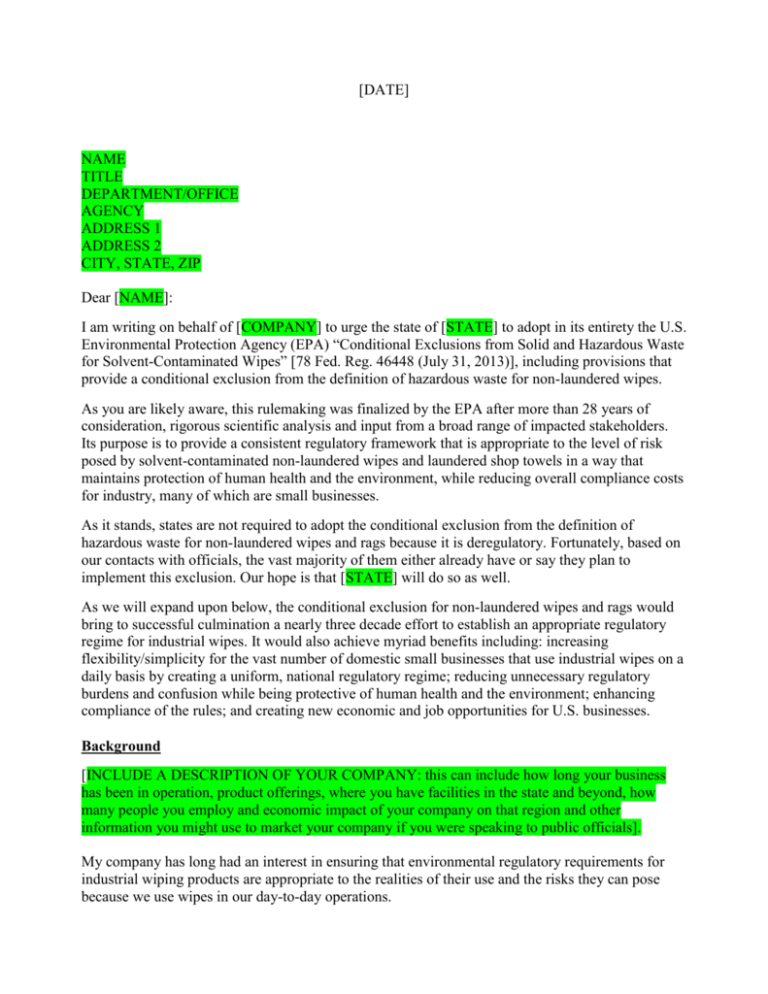
[DATE] NAME TITLE DEPARTMENT/OFFICE AGENCY ADDRESS 1 ADDRESS 2 CITY, STATE, ZIP Dear [NAME]: I am writing on behalf of [COMPANY] to urge the state of [STATE] to adopt in its entirety the U.S. Environmental Protection Agency (EPA) “Conditional Exclusions from Solid and Hazardous Waste for Solvent-Contaminated Wipes” [78 Fed. Reg. 46448 (July 31, 2013)], including provisions that provide a conditional exclusion from the definition of hazardous waste for non-laundered wipes. As you are likely aware, this rulemaking was finalized by the EPA after more than 28 years of consideration, rigorous scientific analysis and input from a broad range of impacted stakeholders. Its purpose is to provide a consistent regulatory framework that is appropriate to the level of risk posed by solvent-contaminated non-laundered wipes and laundered shop towels in a way that maintains protection of human health and the environment, while reducing overall compliance costs for industry, many of which are small businesses. As it stands, states are not required to adopt the conditional exclusion from the definition of hazardous waste for non-laundered wipes and rags because it is deregulatory. Fortunately, based on our contacts with officials, the vast majority of them either already have or say they plan to implement this exclusion. Our hope is that [STATE] will do so as well. As we will expand upon below, the conditional exclusion for non-laundered wipes and rags would bring to successful culmination a nearly three decade effort to establish an appropriate regulatory regime for industrial wipes. It would also achieve myriad benefits including: increasing flexibility/simplicity for the vast number of domestic small businesses that use industrial wipes on a daily basis by creating a uniform, national regulatory regime; reducing unnecessary regulatory burdens and confusion while being protective of human health and the environment; enhancing compliance of the rules; and creating new economic and job opportunities for U.S. businesses. Background [INCLUDE A DESCRIPTION OF YOUR COMPANY: this can include how long your business has been in operation, product offerings, where you have facilities in the state and beyond, how many people you employ and economic impact of your company on that region and other information you might use to market your company if you were speaking to public officials]. My company has long had an interest in ensuring that environmental regulatory requirements for industrial wiping products are appropriate to the realities of their use and the risks they can pose because we use wipes in our day-to-day operations. Historically, under Subtitle C of the Resource Conservation and Recovery Act (RCRA), nonlaundered wipers that contained even one drop of “listed” solvent were regarded as hazardous waste when discarded. Although these rules were intended to eliminate potential loopholes, they were so stringent that they had the unintended consequence of subjecting numerous types of generally nonhazardous materials, including non-laundered industrial wiping products, to overly burdensome and unnecessary waste management requirements. At the same time, wipes that are laundered (a.k.a. “shop towels”) have generally not been subject to federal hazardous waste regulations due to an EPA decision to defer determinations and interpretations regarding regulation of solventcontaminated industrial wipes to states or EPA regions.1 Numerous states have provided laundered shop towels a conditional exclusion from the definition of hazardous or solid waste, but these conditions vary considerably and are typically provided in informal, hard-to-find, and unenforceable “regulatory interpretations,” leaving a patchwork of different, confusing and often conflicting requirements throughout the country. In 1985, manufacturers of non-laundered wipes formally petitioned EPA to conditionally exclude wipes from the RCRA definition of hazardous waste, arguing that these materials are over-regulated because the amount of solvent in the wipes is typically insignificant and because they do not pose a meaningful threat to human health and the environment. In 1987, the Agency received a similar petition to exclude laundered wipes from the RCRA definition of solid waste. Agreeing that these products are over-regulated and finding that managing disposable wipes as solid rather than hazardous waste under RCRA was protective of human health and the environment, EPA included a conditional exemption for them in its 1992 Hazardous Waste Identification Rule (HWIR) proposal, again in its 1993 redefinition of solid waste proposal, and still again in the Reengineering RCRA for Recycling report issued in 1994. Unfortunately, none of these efforts resulted in a final rulemaking that resolved the issue of a conditional exclusion for wipes/rags. EPA spent the next nine years evaluating industrial wipes management options, conducting field visits, collecting data on wiper use and disposal practices, consulting and receiving vast amount of input from stakeholders, and vetting various options. In 2003, nearly 20 years after receipt of the initial petition, the EPA finally proposed a rule to establish a conditional exclusion from the RCRA definition of hazardous waste for non-laundered wipes, and also a conditional exclusion from the RCRA definition of solid waste for laundered shop towels. Scores of stakeholders formally weighed-in on the 2003 proposal. The EPA ultimately decided to redo the risk analysis underlying the 2003 proposal to ensure that it adequately considered comments about possible shortcomings in its initial risk assessment and to account better for the impact on the type of landfill that would be receiving wipes/rags and laundry sludge. After spending the next several years working on the revised assessment, the EPA published in October 2009 a Notice of Data Availability (“NODA”) describing the details of its revised risk analysis. The updated assessment included additional data and information, a new model to evaluate the behavior of solvents in a landfill, revised fate and transport modeling, and an improved approach from the 2003 risk screening analysis to compare the estimates of the solvent quantities disposed to the riskbased solvent loading levels. This includes a methodology to estimate allowable amounts of spent solvents that can be disposed of safely based on modeling scenarios defined in terms of the solvent, 1 Policy Memorandum from Mike Shapiro, Director, Office of Solid Waste, to EPA Waste Management Division Directors, February 14, 1994. landfill type (lined or unlined), exposure route (ingestion, inhalation, dermal absorption), contact media (groundwater, ambient air), and receptor (child or adult). See generally 78 Fed. Reg. 4645154. It was subjected to public comment and external peer review according to established EPA and Office of Management and Budget policies.2 Based on this extremely rigorous analysis, the EPA ultimately concluded that both solvent-contaminated wipes and rags (except for those tainted with trichloroethylene) and laundry sludge can be disposed of in lined, municipal solid waste landfills while still being protective of public health and the environment. Finally, in July 2013, after nearly 30 years under development, the EPA published its final solvent contaminated wipes rule. As noted, the regulation creates a conditional exclusion from the definition of hazardous waste for non-laundered wipes/rags and a conditional exclusion from the definition of solid waste for laundered shop towels. As previously noted, non-laundered wipes and rags that contain trichloroethylene (TCE) are not eligible for exclusion. Requirements for achieving such exclusions are nearly the same for both laundered and nonlaundered wiping products. Under the final rule, in order to be eligible for exemption, generators of both wipes and shop towels must: Ensure that wipes and shop towels are accumulated, stored, and transported in non-leaking, closed containers capable of containing free liquids and labeled “Excluded SolventContaminated Wipes.” Not accumulate wipes/shop towels for longer than 180 days. Ensure that when wipes are transported off-site, they contain “no free liquids” as determined by the Paint Filter Liquids Test (EPA Methods 9095B). Maintain recordkeeping. Generator facilities will have to keep documentation onsite that includes: 1) the name and address of the landfill/combustor or laundry/dry cleaner receiving wipes/towels when sent off site; 2) records showing that the 180-day accumulation time limit is being met; 3) a description of the process the generator is using to meet the “no free liquids” condition. Assuming these standards are met, non-laundered wipes will be able to be disposed in either a lined, non-hazardous waste landfill or in a hazardous waste landfill; a municipal waste combustor regulated under New Source Performance standards (section 129) under the Clean Air Act or a hazardous waste combustor or hazardous waste boiler or industrial furnace. Meanwhile, laundered shop towels may be sent to either an industrial laundry or dry cleaner that is subject to effluent discharge requirements under the Clean Water Act and has a National Pollutant Discharge Elimination System (NPDES) permit or is subject to indirect discharge limitations imposed by a publicly-owned treatment works (POTW). 2 You can read a summary of the extensive risk analysis process in the preamble to final rule. Documents supporting the comprehensive risk analysis include ‘‘Landfill Loadings Calculations for Disposed Solvent-Contaminated Wipes and Laundry Sludge Managed in Municipal Landfills,’’ October, 2008; ‘‘Risk-Based Mass Loading Limits for Solvents in Disposed Wipes and Laundry Sludges Managed in Municipal Landfills,’’ October, 2009 and ‘‘F001–F005 SolventContaminated Wipes and Laundry Sludge: Comparison of Landfill Loading Calculations and Risk-Based Mass Loading Limits,’’ August, 2009, can be found in the docket associated with this rulemaking [RCRA Docket Nos. 2003-0004]. Now that the rule has been finalized, states are left to decide whether to implement the final product. [COMPANY] argues that doing so would achieve numerous laudable objectives as outlined below. 1) Increase Regulatory Flexibility/Simplicity for Domestic Small Businesses and Enhance Regulatory Compliance by Creating a Uniform, National Regulatory Regime As the EPA itself noted, until the rule was finalized, its failure to clearly establish the regulatory status of industrial wipes under RCRA led to the development of diverse and confusing regulatory schemes for these materials across various states, a situation exacerbated by the fact that very few states had set forth their positions regarding laundered industrial wipes in transparent, promulgated regulations. See generally 68 Fed. Reg. 65591-92. This made it difficult for the hundreds of thousands of U.S. businesses like mine that use these wipes in their day-to-day operations, the vast majority of which are small businesses, to comply with regulatory requirements relating to wipes. As the agency notes in the preamble to its 2003 proposed rule, “generators of solvent-contaminated wipes have asked EPA over the years to clarify our position on both disposable and reusable wipes.” 68 Fed. Reg. 65591. As a representative from the printing industry noted during a March 9, 2004 public meeting on this matter, “Over the years the printing industry has continued to identify the ambiguity of the state policies as they apply to both disposable and reusable solvent contaminated wipes as a major concern…It has long been our intention to encourage the U.S. EPA to establish a federal regulation that levels the playing field and provides an element of consistency to this issue.”3 Indeed, a review of the administrative record for this rulemaking reveals numerous submissions from the printing, electronics, automotive and other industries calling for the EPA to establish a clear, uniform national policy to bring consistency and enhance their ability to comply. These same groups cheered the EPA when it finally delivered a simple and straightforward rule that clearly lays out generator obligations to achieve their respective exclusions for both classes of products. 2) Prevent Unnecessary Over-Regulation, Increase User Options, and Create New Economic Opportunities Over the years, impacted industries have submitted reams of scientific data demonstrating that wiping products are indeed over-regulated and can be handled, managed and disposed of safely without the onerous controls currently in place. EPA shared this position, as evidenced by numerous statements in the administrative record for the wipes rule in which it notes that these materials are excessively regulated, and the fact that EPA had released several proposals that attempted to conditionally exclude wiping products from onerous hazardous waste requirements.4 This well-established over-regulation of non-laundered wipes and rags obviously creates costs that are unnecessary to achieve environmental objectives. One of these is limiting the wiper options available to those who use wipes. Generators in clean environments such as electronics, biopharmaceutical, medical device and other high tech manufacturing frequently prefer using nonlaundered wipes and rags due to various attributes such as increased sterility, absorbency, texture and low lint particles. However, due to the additional costs of complying with the excessive 3 March 9, 2004 Statement of Marci Kinter, Specialty Graphic Imaging Association International. For example, a Technical Background document supporting the 2003 proposed rule states that “[c]urrent federal rules appear to over-regulate these materials, such as when very small amounts of hazardous solvent are applied to industrial wipes.” 4 hazardous waste management restrictions applicable to non-laundered wipes and rags, wipes users like my company often feel compelled to use laundered shop towels in situations where nonlaundered wipes or rags are better suited to the task at hand. For example, in a February 26, 2010 submission to the EPA, the National Automotive Dealers Association, which represents some 17,000 automotive and truck dealers, the vast majority of which are small businesses, called upon the EPA to finalize revisions to the existing waste regulations, noting that “[d]ealerships and other small businesses want the ability to choose among wipe products,” and contended that making these regulatory revisions would create a more even playing field between disposable and reusable wipes. Moreover, this over-regulation hasn’t merely impacted users of wipes; it has also unnecessarily burdened manufacturers and distributors of these products. Conservative industry estimates show that eliminating this needless over-regulation of disposable wipes and replacing it with smart, uniform, and straightforward national management and disposal requirements described in the final rule will open up a new market for these products, in the range of $718 million annually. That’s $718 million in jobs creation, and $718 million in U.S. economic growth that is lost each year due to unwarranted over-regulation.5 3) Bring to a Successful Conclusion a Nearly Three Decade EPA Effort As noted in detail above, the EPA invested years of staff work and a lot of money studying this issue, conducting public meetings, engaging and responding to stakeholder input, gathering and evaluating data, conducting internal and external government reviews, and creating two risk analyses. Based on this extensive work, EPA managed to develop a well-balanced rule that achieves numerous laudable objectives detailed above. In recognition of its many benefits, twelve states have already implemented the rule in its entirety, another 25, including [STATE], indicate they plan to or are highly likely to accept it in its entirety, while another nine indicate they are still evaluating the rule.6 [COMPANY] would strongly urge you and your colleagues to implement this rulemaking in its entirety as quickly as possible. After literally decades of work and study, the time has come for all states to fully implement this long overdue and highly anticipated rulemaking as expeditiously as possible. As already noted, doing so will: 1) rectify unnecessary over-regulation in existing hazardous waste rules; 2) bring clarity and certainty to the covered community by creating a uniform, national regime; 3) and aid the vast number of small businesses across the nation who use these wipes on a daily basis in creating new economic and job opportunities, all while being protective of human health and the environment. Should you have any questions or need further information, please feel free to contact me at [PROVIDE EMAIL AND TELEPHONE]. Sincerely, 5 6 “INDA Impact” Report, 2014. Based on direct contacts in Q1 2014 with state officials responsible for overseeing the rule’s implementation.
